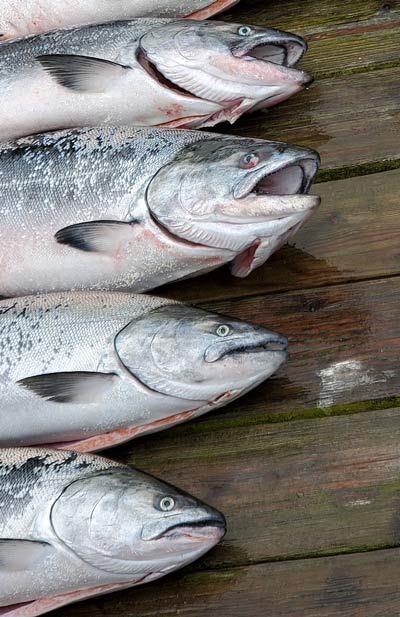WHAT YOU NEED TO KNOW: The Pacific Fishery Management Council unanimously recommended a full closure of the ocean salmon season for the second consecutive year. The Newsom Administration is requesting another Federal Fishery Disaster Declaration to financially support impacted communities, which would build on the actions and investments that Governor Newsom has already taken to boost salmon populations.
April 11, 2024 - SACRAMENTO — Today, Governor Gavin Newsom and Lieutenant Governor Eleni Kounalakis announced a request for a Federal Fishery  Disaster Declaration to support impacted fishing communities. This request and the recommended season closure will protect salmon populations and support the fishing industry.
Disaster Declaration to support impacted fishing communities. This request and the recommended season closure will protect salmon populations and support the fishing industry.
These actions build on Governor Newsom’s Salmon Strategy for a Hotter, Drier Future to address this decades-long crisis and rehabilitate these populations. The Newsom Administration and Legislature have already spent over $800 million in the past few years to protect and restore salmon populations, and the federal government allocated $20.6 million following last year’s disaster declaration request.
Acting Governor Kounalakis, on behalf of Governor Newsom, submitted the request to U.S. Secretary of Commerce Gina Raimondo after the Pacific Fishery Management Council recommended a full closure of California’s commercial and recreational ocean salmon season. If approved, the Federal Fishery Disaster Declaration would provide needed relief to impacted communities for a second consecutive season.
“Decades of climate extremes have severely impacted our salmon populations, and we’re taking action to address this crisis for the long-term. We’ll continue working with the Biden Administration and Congress to ensure California’s fisheries and impacted communities are supported during this critical time,” said Governor Gavin Newsom.
“California is taking action to get our salmon fishing communities the support and relief they need. This request is a critical tool to support impacted Californians, and we look forward to getting families the help they need,” said Lieutenant Governor Eleni Kounalakis.
HOW WE GOT HERE: Years of extreme droughts, severe wildfires, and associated impacts to spawning and rearing habitat, harmful algal blooms, and ocean forage shifts have combined to result in low stock abundance forecasts over the past couple of years for Sacramento River Fall Chinook and Klamath River Fall Chinook.
ACTIONS & INVESTMENTS UNDERWAY: The Newsom Administration and Legislature have already spent over $800 million in state investments over the last three years to protect and restore salmon populations.
- New Strategy: Governor Newsom launched California’s Salmon Strategy for a Hotter, Drier Future that specifies six priorities and 71 actions to build healthier, thriving salmon populations in California. Last month, CDFW distributed $50 million to support this strategy with a diverse array of habitat restoration projects in the Sacramento-San Joaquin Delta, McCloud River, and wetland and meadow projects statewide.
- Largest Dam Removal in History: Restoring the Klamath River, which was once a prodigious producer of salmon, by removing four obsolete hydroelectric dams. One dam was taken down last September and the rest are slated for removal, restoring nearly 400 miles of once-blocked river to salmon, steelhead, lamprey and other native fish species.
- Bringing Fish Back to Historical Habitat: Moving endangered adult winter-run and threatened spring-run Chinook salmon to the upper reaches of Sacramento River tributaries at the height of the 2020-2022 drought, where colder water temperatures better support spawning and help salmon eggs survive. This effort returned adult winter-run to the North Fork of Battle Creek for the first time in more than 110 years.
- Doing the Science: Boosting the resilience of hatchery-raised salmon with injections of thiamine (Vitamin B) to counter a deficiency that researchers believe has depressed survival of their offspring in recent years. The deficiency has been tied to shifting ocean conditions and salmon feeding primarily on anchovies compared to a more diverse diet of forage fish, krill and other species.
- Fixing the Landscape: Restoring approximately 3,000 acres of tidal wetland where the Sacramento River drains to San Francisco Bay, creating habitat beneficial to native fish and wildlife, including salmon.
- Flows for Fish: In the Scott and Shasta rivers in the Klamath Basin and Mill Creek in the Sacramento Valley, beginning efforts to establish minimum instream flows while working with local partners and tribes on locally driven solutions.
- Expanding Partnerships with Tribes: From signing a co-management agreement with the Winnemem Wintu Tribe to bring salmon back to the McCloud River for the first time since construction of Shasta Dam, to investing in tribally led restoration like the Oregon Gulch, Farmers’ Ditch, and post-McKinney fire projects with the Yurok and Karuk Tribes, to beaver reintroductions.
- Modernizing and Removing Infrastructure: Reaching agreement with local and federal partners on a framework to reopen miles of Yuba River habitat to multiple native fish species. The agreement sets the stage for the return of imperiled spring-run Chinook salmon to their native habitat in the North Yuba River for the first time in more than 100 years. And, taking the next big step with a coalition of counties, tribes, and fish conservation groups to create California’s longest free-flowing river – the Eel River – through the decommissioning of outdated infrastructure.
Source: Office of the Governor









